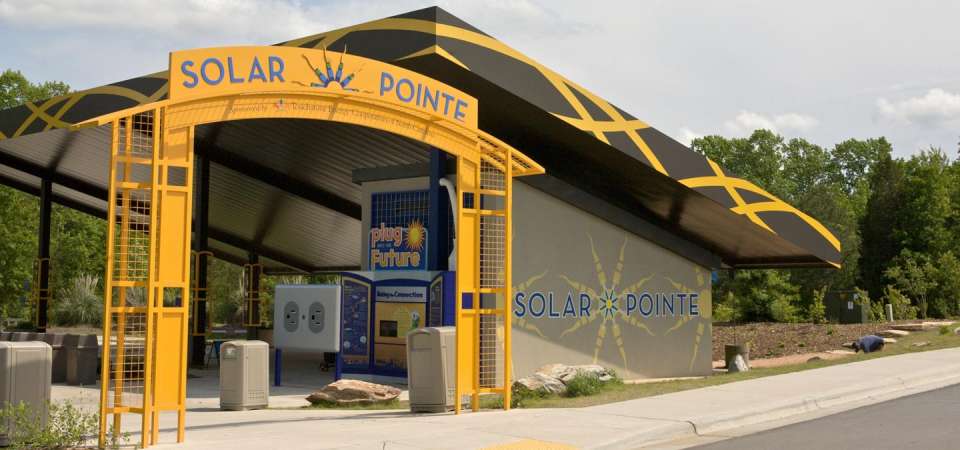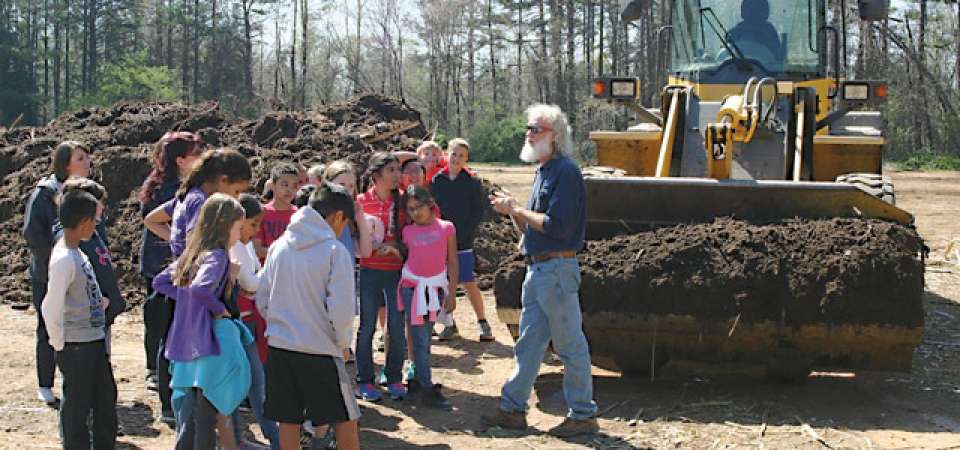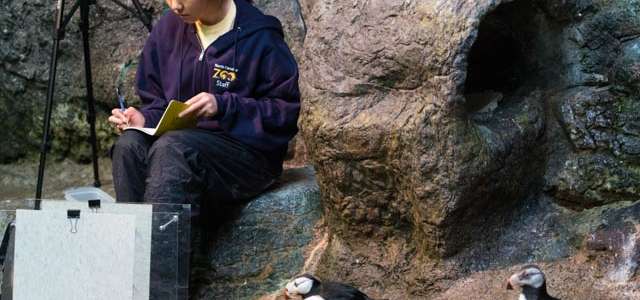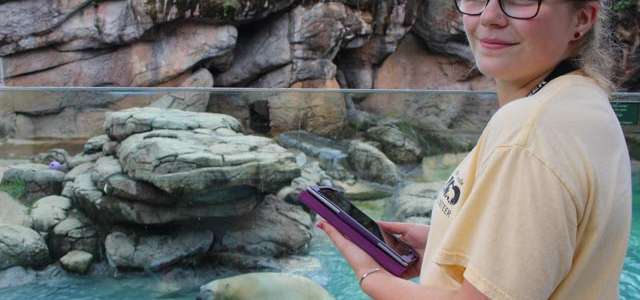


On April 16, Purgatory Mountain Hiking Trails will be closed to the public for a controlled burn starting at 9 a.m. Zoo guests may see smoke in the area. We do not anticipate any adverse reactions from the animals due to the smoke.



The North Carolina Zoo is committed to sustainability. We work hard to reduce our impact on the environment and raise awareness about green practices you can use at home too. On this page you can learn about how the Zoo uses techniques like solar energy, composting, and recycling to reduce our impact on the natural world.
The North Carolina Zoo is home to more than 1,800 animals, each receiving individualized care to ensure they have ample opportunities to thrive. But we also embrace our responsibility as caretakers of the Earth. Consequently, our concern for the natural environment extends well beyond the animals living within the Zoo’s property boundaries, and the conservation projects on the ground we participate in.
For more than 30 years, we have been invested in natural resource conservation as a way to maintain natural ecosystems and prevent environmental degradation. The Zoo is also a long-term member of North Carolina’s Environmental Stewardship Initiative, which is a designation for organizations displaying a commitment to exemplary environmental performance beyond what is required by law.
which signifies the Zoo’s commitment to minimizing waste, conserving natural resources, and preventing environmental degradation in every aspect of Zoo operations.
Beginning with the initiation of its first ‘green practices’ in the late 1980’s, the Zoo has enacted numerous projects, such as high efficiency LED lighting and HVAC control systems. Current priority initiatives include intensive recycling and composting programs, and a comprehensive approach to minimizing single-use plastics throughout Zoo operations. Reducing our plastics use helps accomplish numerous goals, including reducing consumption of fossil fuels (most plastics are made from petroleum), eliminating potential marine debris, and addressing growing concern over microplastic pollution.
Our Green Practices Program has grown rapidly over the past three decades. Today, the Zoo:
The Zoo's Environmental Policy
The Zoo's Environmental Policy.
“It is the policy of the North Carolina Zoo to conduct operations in an environmentally responsible and sustainable manner; to comply with environmental laws, regulations and other requirements; to reduce use of resources and generation of waste; to strive for continual improvement; and to lead by example.”
G Growth in knowledge and continual improvement
R Reduction in use of resources and waste
E Environmentally responsible and sustainable operation
E Environmental protection and pollution prevention
N Necessary compliance with environmental laws, regulations and other requirements
Environmental Management System in place to minimize our impacts
We have identified actions, materials, and processes which could have negative impacts to the environment. Some impacts may be over-consumption of natural resources and loss of habitat for wildlife species. Other impacts might increase pollution; degrading air, water, or land. Some impacts could even result in health consequences for Zoo staff or animals. When left unmitigated, these impacts would ultimately result in increased costs for the citizens of North Carolina, sometimes in the short term but especially over the long term. To reduce such impacts, all Zoo staff, volunteers and contract staff are responsible for:
An internal “Green Team” that has actively met since 1994
The North Carolina Zoo’s Conservation Captains are our internal Green Team. Originally convened in 1994 at the suggestion of staff, the “ConCaps” suggest and oversee many of the initiatives and green practices instituted in the park. This team also conducts informational lunch events for staff and volunteers, coordinates the Zoo Earth Day Celebration each April, works to keep staff informed about proper procedures for recycling, conducts four Adopt-A-Highway cleanups each year, and hosts the annual “Use Less Stuff Sale” each November to promote the idea of “reuse before refuse!”
Recycling office paper in 1989
One result from the Zoo’s 1989 waste audit was the institution of three paper conserving measures. (Note that in 1989, few staff had regular computer access.) At that time, the Zoo relied on paper photocopies to distribute information to staff members, and consequently used a significant amount of paper. One early goal was to encourage copying on both sides of a sheet of paper. Even today, our printers continue to have double-sided printing as the default setting. We also began collecting mixed office paper for recycling. This has never been an elaborate undertaking, and many offices still use old cardboard boxes as recycle bins. Lastly, we began a policy of collecting used Zoo maps and brochures—be sure to look for the collection bin when you exit the Zoo.
Makes use of centralized thermostatic controls to minimize HVAC energy use
Heating, ventilation, and air conditioning (HVAC) of Zoo buildings consume a significant amount of energy. These systems use more when poorly maintained, or when staff must manually adjust the settings. In the early 1990s, the Stedman Education building opened as our primary business office. It became clear that some liked it hot, some liked it cold, and very few would reset thermostats at night and on the weekends. Use of a centralized control system with standard temperature settings, especially when the building was not occupied, reduced energy costs by 25% the very first year the system was in place. Though we have been through several generations of controls over the years, the Zoo still uses a centralized control system to conserve HVAC energy.
Monitors energy use in all of our buildings
One of our best tools to detect energy inefficiencies has been the installation of electric meters in every building at the Zoo (there are more than 100 of them). Each month, our staff compares power consumption with previous months and years. When discrepancies arise, we check weather conditions to see if unusual circumstances altered the demand for power. Power consumption anomalies help us spot problems with HVAC systems or lighting. Meters help maintenance staff be proactive, initiating repairs before a system breaks down.
Composts almost 2,000 tons of manure and organic waste each year
The Zoo’s elephant herd is responsible for a full ton (2,000 pounds) of manure each day. Add in waste from the rhinoceroses, antelope, zebra, giraffe, elk and bison, and you can imagine one large manure pile. Disposal is problematic and expensive, since it is not acceptable to discard this material into a landfill. Hauling this waste away from the Zoo would degrade the air and increase fuel consumption.
During the 1980s, our Horticulture section began a small-scale composting operation. Initially we only composted plant and grass clippings associated with maintaining Zoo grounds. As we added the North America section, it was clear that the compost operation needed to expand, not only to process more plant material, but to also allow addition of manure to the mix. In 1996, we received permission from North Carolina to develop a 2-acre site to handle our growing composting needs.
Today, we annually process about 2,000 tons of manure and plant waste on this site, surfaced with repurposed fly ash from a nearby coal power plant. Windrows take about three months to turn from manure and clippings into nutrient-rich compost. Bacteria and germs in manure do not survive the composting process. We ensure this by sending a sample from each windrow to North Carolina State University for testing. Rainwater is captured in a retaining basin and pumped into the sanitary sewer. That water goes through the City of Asheboro’s treatment plant.
All of the compost generated here, stays here, too. We use every bit in our horticulture operations. This also saves money. Since we do not have disposal fees, and since we use the compost on site and do not have to buy organic soil supplements, the Zoo is able to avoid some rather substantial costs.
The most recent development in compost and waste reduction has been adopted by Service Systems Associates (SSA) our food service contractor. In 2017, SSA initiated a project to compost all the food scraps associated with the Zoo’s meal preparation activities. Representatives collected these materials from the five restaurants and transported them to the compost area. But this was not enough. SSA has gone even further, by eliminating most single use, disposable plastics used on the Zoo’s grounds. This is one reason you will not be able to get a straw at the Zoo, and that all beverage cups are compostable or refillable souvenir cups. All of the spoons, knives, and forks distributed at the Zoo are plant-based, compostable plastic. Plates and bowls are also fully compostable plant fiber. We have also acquired special “sorting” waste containers for all food plaza areas in order to facilitate more composting that will move the Zoo closer to our target of no landfill waste.
Employs LED lighting to reduce energy consumption
In November of 2015, in partnership with the NC Green Building Commission and Cree Lighting of the Research Triangle Park, the Zoo was able to convert all of the lighting in our primary Auditorium to energy efficient LED Lighting. When constructed, the 2,500 square foot room had four different types of light fixtures installed. Some were metal halide-type fixtures that used mercury vapor bulbs: these use considerable energy during start-up. Some were fluorescent fixtures that also used bulbs with mercury vapor. Some were 500-watt recessed fixtures that generated heat, causing the HVAC system to be less efficient. In all, the bulbs at the time consumed over 14,000 watts of power to light the room. Replacing those light fixtures with 20 LED lights has given the room the same light, but only requires about 500 watts of power—almost 30-times less energy.
Monitors incoming water and outgoing waste water
The North Carolina Zoo uses about 40 million gallons of potable, drinking water each year. Almost every aspect of Zoo operation requires water, from bathrooms to the veterinary hospital. We have taken several steps to reduce water usage. For example, several meters keep track of the incoming potable water; this helps to isolate leaking pipes, or a bathroom with bad toilet valves, which in turn, allows us to fix problems before incurring wasted resources or the expenses of a breakdown.
Special meters were installed that enable our water supplier, the City of Asheboro Water Resources, to better understand the Zoo's water disposal needs. In most homes and businesses, water meters measure the amount of incoming water. However, sanitary sewer fees are often calculated by doubling the amount of potable water delivered by supply pipelines, to also account for water that goes out via sewer drains (dishwater, bathwater, toilet flushing, etc.). Much of the Zoo's incoming water is used for animals to drink, and for plant irrigation and never goes into a drain. To better understand our water needs and manage our sewer costs, we have also installed meters on our outgoing sewer line. These meters show that only about 60% of the water we buy goes into the treatment system. Our relationship with the City of Asheboro Water Resources enables us to pay the actual costs of our water usage, rather than the estimated costs for sewage disposal and treatment. These measures also benefit the City of Asheboro Water Resources, who is able to better plan for the area’s water disposal needs.
Two acre constructed wetland to prevent pollution from storm water runoff
Some of the cars that park in the North America parking area have small leaks of oil, antifreeze, or brake fluid. Rain washes automotive chemicals into the Zoo’s lakes, which can harm our area’s aquatic life and reduce water quality. Nature can neutralize these chemicals, keeping them from harming insects, fish and amphibians living downstream, but it takes time. To reduce the harm of these chemicals on our natural world, in 2010 the Zoo officially announced the creation of the constructed wetland, adjacent to the Dragonfly Point picnic area. This wetland can filter a one-inch rain event every seven days. During this filtration process, water-based chemicals dilute so they do less harm. Fungi and bacteria break these diluted chemicals down, rendering them harmless before entering the lake. To make the process more effective, plants maintained around the wetland slow the flow of water so heavier chemicals settle to the bottom, where aquatic organisms break those down over a longer period of time.
Makes use of xeriscaping and computerized irrigation controls to minimize water consumption
Xeriscaping is the practice of using native plants that tolerate local weather and soil conditions. It also includes the incorporation of drought-tolerant plants, allowing attractive gardens that do not require excessive irrigation systems. When water levels are appropriate, the Zoo takes water from either the North America or the Africa lake for irrigation. This decreases costs, and places less of a demand on local water resources. We also became partners with the Rain Bird Corporation and have installed state-of-the-art monitoring systems that tell our Horticulture supervisors when and how long we should turn on the sprinklers on any given day. Readings reflect detected temperatures, relative atmospheric humidity, rain potential and ground moisture. By implementing this system we are able to provide proper water for the plants without over watering or wasting resources.
Instituted a system of Integrated Pest Management to make use of the least toxic, most-effective means for controlling insects and other pests
Integrated Pest Management (IPM) is one way the Zoo minimizes its use of potentially toxic pesticides. For example, to prevent flies at the compost site from becoming problematic, a biocontrol was introduced in the form of a small wasp that preys upon fly eggs and larvae. These wasps do not sting. Biocontrols are also used in our indoor habitats, where predatory insects eat plant-damaging bugs. There are times stronger measures are needed to control a plant or insect pest for which biocontrols are not effective. Training and certification by the NC Department of Agriculture assures that staff do not allow harmful chemicals to wash into lakes, ponds and creeks on and around the Zoo property.
Installed a grid connected, photovoltaic solar array in 2008
Solar Pointe is a collection of three picnic shelters near the North American bus parking lot. Each pavilion rooftop has 3,200 square feet of photovoltaic panels that can generate a maximum of 104 kilowatts of power per hour. These panels supply energy to the local power grid through our partnerships with Carolina Solar Electric Company and the Randolph Electric Membership Cooperative. Though 104 kilowatts is not a huge amount of electricity, this supply helps reduce the local demand for energy on hot and cold days when local homes need it for cooling and heating.
Acts locally to make global changes
The Zoo has a substantial role in local initiatives to protect wildlife and wild places. A team of Zoo staff functions as the “Arctic Ambassador Center” (AAC) to promote activities that can help mitigate the effects of atmospheric carbon. The AAC takes the lead on tree planting projects with our “Acres for the Atmosphere” plantings. Over 400 trees planted on public and semipublic lands provide shade, reduce demand for energy to cool facilities and serve as a carbon sink. The Arctic Ambassadors also recognize local and regional businesses with the “Paw of Approval.” This recognition acknowledges businesses that are working to institute green practices and become models of environmental sustainability.
Since 2004, the Zoo has coordinated and led local efforts to reduce aquatic litter as part of the International Coastal Cleanup. Though the Zoo is not near the coast, both river basins in Randolph County lead directly to the ocean. Litter can harm freshwater dependent animals too, including turtles, fish, amphibians, birds and mammals. In 2016, the North Carolina Zoo became the only Zoo in the country to host a Keep America Beautiful Affiliation on behalf of the County. Through this affiliation, the Zoo works with schools, civic groups and other citizens to provide grassroots level education and conservation initiatives that protect water and air resources through litter reduction, improved recycling efforts and community beautification projects.
Makes use of appropriate alternative fuels in Zoo vehicles
Each year, the North Carolina Zoo hosts more than 800,000 guests. Moving guests from place to place can be difficult, and can use a significant amount of petroleum fuel. In 2015, the Zoo purchased the first of two trams that run on low pressure propane gas — a much cleaner fuel than diesel, and for vehicles that must run all day, during the hottest part of the year, means that the Zoo creates less particulate soot, sulfur oxide and nitrous oxide emissions. It is much healthier for the animals, staff and volunteers, and guests!
Reuses or recycles steel and aluminum
The Zoo is like a small town with more than 700 total employees in the busy season. The graphics department produce signage around the Park. A design crew creates our amazing, naturalistic habitats. Facilities and equipment staff fabricate and repair structures and make parts for Zoo vehicles. All of these departments use significant amounts of metal. At times, the Zoo purchases more than is necessary for a job, saving the leftovers for other projects. Sheet steel can become a sign. Material recovered from renovated habitats and structures often becomes part of other projects. Unusable steel and aluminum ultimately go to the local recycling center.
A Full Steward in North Carolina’s Environmental Stewardship Initiative
The State of North Carolina, through the Department of Environmental Quality, developed the Environmental Stewardship Initiative (ESI). This is a voluntary, no cost program, designed to “promote and encourage superior environmental performance by North Carolina’s regulated Community.” ESI is a high profile way that the Zoo is an example of sustainability in our State. Our status as a Full Steward in this program signifies that we have developed and implemented our Environmental Management System, that we set and pursue aggressive goals in managing out potential impacts and that we exceed minimal levels of compliance with guidelines and regulations.
Electric Vehicle charging stations
In continuing efforts to maintain air quality and encourage new transportation technology, the Zoo provides guests with eight charging stations for electric vehicles. Four of these are located in North America parking lot “D," immediately in front of the Stedman Education Building. Four charging stations are also located next to the Solar Pointe picnic area in the North America parking area. Parking spots are marked for Electric Vehicles Only.
Has been recognized locally, regionally, and nationally for sustainability initiatives
Our green practices and sustainability initiatives draw considerable attention locally, regionally, nationally and globally! The Zoo has received awards from the City of Asheboro, Randolph County, Multi-County Partnerships within the Piedmont Triad region, state-level agencies, the Association of Zoos and Aquariums, and the International Zoo Educators Association to name a few. Here are just some of the awards and recognitions we have to show for our efforts:
1996 - The NC Recycling Association award for Outstanding Source Reduction.
1999 - Governor's Outstanding Source Reduction Award.
2000 - The "Conservation Captains" received the Department of Environment and Natural Resources (DENR) Environmental Sustainability Award.
2001 - The Zoo's Compost Program was awarded the Carolina Recycling Association's Outstanding Compost Program Award.
2002 - The Zoo was certified under ISO 14001 for Environmental Management System.
2004 - State Government's NC Green Team awarded the Zoo the first State Government Sustainability Award.
2005 -The Zoo was recognized by the Department of Environment and Natural Resources (DENR) for The Cell Phone recycling Program.
2005 - Sustainable NC awarded the Zoo the 2005 NC Sustainability Award for organization-wide sustainability efforts.
2006 -NC Big Sweep awarded the Zoo the Caroline Parker Outstanding Achievement Award.
2006 - The Department of Environment and Natural Resources Sustainability Team recognized the Zoo Biodiesel Program.
2006-The International Zoo Educators Association invited the Zoo to their international Conference in Pretoria, South Africa, where we presented details of our Green Practices Program to Educators from around the World
2007 - NC Land Trust recognized the Zoo as the State Government Conservation Partner of the Year.
2012-The Zoo became the inaugural recipient of the Association of Zoos and Aquariums Green Award, recognizing our efforts with Sustainability initiatives
2017-The NC Source Water Collaborative cited the Zoo with an Award of Excellence for efforts taken to protect Surface Water Quality
Partners: BB&T Bank, Carolina Solar Energy, NC Clean Water Management Trust Fund, NC Department of Transportation, NC Environmental Stewardship Initiative, NC Green Power, North Carolina Electric Membership Cooperatives, Randolph Electric Membership Corporation

Conservation is at the heart of what we do at North Carolina Zoo and extends to every staff member at the zoo. Learn about ways our animal keepers and other staff are helping to save wildlife.

The North Carolina Zoo is a living laboratory, offering unique opportunities to better study wild animals.